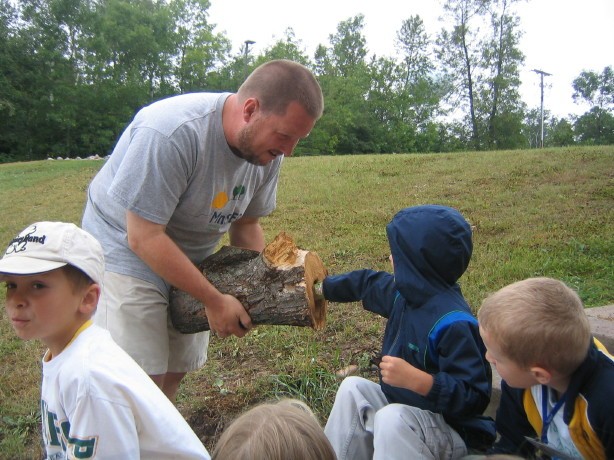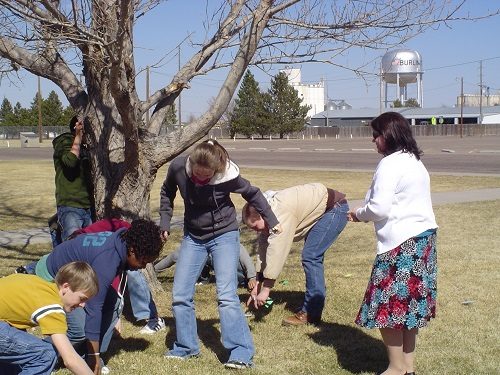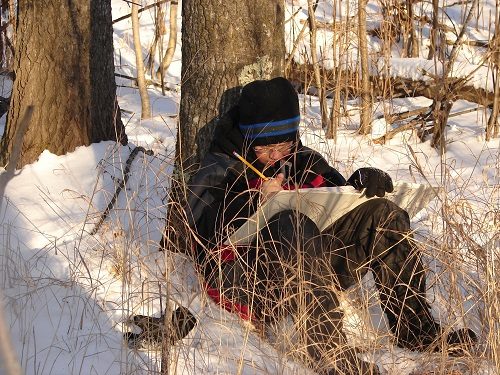 Quick—what’s your favorite Project Learning Tree activity? Now think again. Where do you do it?
Quick—what’s your favorite Project Learning Tree activity? Now think again. Where do you do it?
If you answered “indoors,” reflect… could you have done it outdoors? Even reading a story, like “In the Forest of S.T. Shrew” found in PLT’s PreK-8 Guide Activity 8, takes on so many added dimensions, if simply read outdoors.
We teach indoors for lots of reasons. After all, someone built us a building. Indoors feels secure. There are four walls and a ceiling. It never rains, snows, or darkens, and it’s always a comfortable temperature. We have desks, pencils, SmartBoards, and electrical outlets. However, it can deprive us of stimulation.
Why Teach Outside?
Intellectually, we’re aware of benefits of learning outside the four walls of the classroom. A growing body of research reveals the significance of early experiences with nature as an important factor in developing environmental awareness (Taylor and Kuo, 2006; Orr, 2004). A quick glance at the voluminous research abstracts listed on the Children and Nature network reveals several research studies that glow about how nature, hands-on learning, and authentic experiences can:
- Improve test scores, attendance, attitudes toward learning
- Positively affect child physical, social, interpersonal, and aesthetic development
- Alleviate symptoms of ADHD and ADD
- Help ELL learners learn new vocabulary
- Improve child health
- Allow children who learn differently from others to become leaders and shine
With benefits like these, teaching outside should be a “no-brainer.” Yet most teachers don’t go outside with their students. Why?
Barriers to Teaching Outside
 Dr. Cynthia C. Gardner from Lander University in South Carolina wrote a paper called “Why Some Teachers are not using the Schoolyard Environment.” (For a copy, contact cgardner@lander.edu.) She had taught at a South Carolina school that had three beautiful designated outdoor teaching areas (a pine forest, a pond, and a wetland), yet observed very few teachers using those spaces. To find out why, Gardner distributed 50 surveys to teachers of kindergarten through grade 5. She received 35 responses. A quick summary of the results:
Dr. Cynthia C. Gardner from Lander University in South Carolina wrote a paper called “Why Some Teachers are not using the Schoolyard Environment.” (For a copy, contact cgardner@lander.edu.) She had taught at a South Carolina school that had three beautiful designated outdoor teaching areas (a pine forest, a pond, and a wetland), yet observed very few teachers using those spaces. To find out why, Gardner distributed 50 surveys to teachers of kindergarten through grade 5. She received 35 responses. A quick summary of the results:
- Sixty-six percent (23 teachers) never used the pond area; 37% (13 teachers) never used the pine forest; and 40% (14 teachers) never used the wetland.
- Most used the outdoor areas 1-5 times a year. Only one teacher used it 6-10 times a year.
- Reported levels of comfort teaching outdoors: low 31% (11 teachers); medium 40% (14 teachers), high 29% (10 teachers)
- Perception of importance of adding the natural areas into the curriculum: Not or somewhat important: 60% (21 teachers); important or very important: 40% (14 teachers)
Teachers were also asked to identify barriers to teaching outside. The barriers fell into five categories:
- curriculum standards,
- daily schedule,
- supervision of children,
- hazards, and
- lack of knowledge.
Only the K-2 teachers cited “supervision of children” and “natural hazards” as barriers. Only grade 3-5 teachers cited “lack of knowledge.” Teachers from all grade levels cited the curriculum standards and the daily schedule.
While Gardner’s study focuses only on one school in South Carolina, I suspect her results are pretty similar elsewhere. I’ve worked with hundreds of teachers over the years. I’ve heard lots of excuses, concerns, and barriers to going outside. I could add a few more barriers to Gardner’s list:
- kids aren’t properly dressed for the weather,
- we “don’t have nature,” and
- the teachers simply don’t like nature/cold/wet/wind/sun/snow/ticks/etc.
Top 10 Tips For Teaching Outside

Attend a PLT workshop and become comfortable teaching outdoors – in urban, suburban, and rural environments.
I know which teachers consistently take their students outside to learn, and have heard their glorious testimonials on the benefits of nature in academic settings. Intrigued by Gardner’s paper, I asked a few Minnesota teachers – one preschool, one elementary, two secondary –to give me their “Top Ten” tips for colleagues who have never taught outside. If you’re mentoring in a new teacher or contemplating the outdoors yourself, I share these tips.
Teachers like these exist everywhere. Find a mentor at a local nature center, through your state environmental education organization, or contact your state PLT program coordinator for help.
Also check out the many useful Appendices in PLT’s Envrionmental Experiences for Early Childhood guide, for example “Playing It Safe Outdoors”, “Taking Neighborhood Walks”, “Setting Up an Outdoor Classroom”, “Encouraging Unstructured Outdoor Play”, and more.
References:
- Orr, D. W. (2004). Earth in mind: On education, environment, and the human prospect. Washington, DC: Island Press.
- Taylor, A. F., & Kuo, F. E. (2006). “Is contact with nature important for healthy child development? Statement of the evidence.” In C. Spencer & M. Blades (Eds.). Children and their environments: Learning, using and designing spaces (pp. 124 – 140). Cambridge University Press, Cambridge, U.K.



2 comments on “Why Teach Outside?”
Hi there,
I am currently in my third year of study to be a primary school teacher and I am looking into outdoor education. This article raises some really valid points that I would love to reference in my essay. What date was this article written, and do you have the reference for Gardners research?
Many thanks
So glad you found this article helpful. It was published Nov 2010. Please contact Cynthia Gardner cgardner@lander.edu for more information and the reference for her research, thanks!